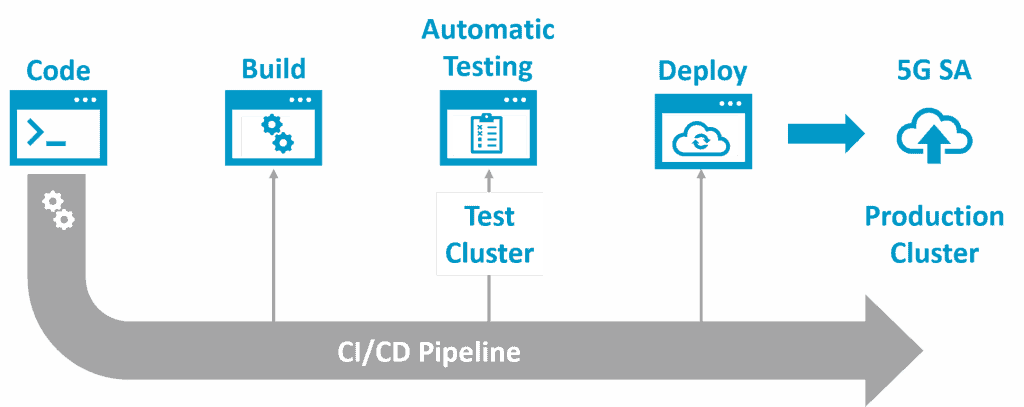Our 5G Standalone Blog Series Begins Here
This blog is the opening part to our 5G Standalone series. The series will discuss the new wave of 5G Standalone (SA) networks beginning to roll out, its core architecture, and key enablers. Continue reading to learn more about SA 5G and why automated, cloud-native assurance must be the cornerstone to its successful deployment.
Introduction: Taking 5G to the Next Level
5G promises a future in which people are always connected with technology deeply embedded into society, providing high speed and instant connectivity. The initial wave of 5G is focused on Non-Standalone (NSA) deployments, with operators leveraging their existing 4G network infrastructure and core. In this phase, operators can deliver enhanced mobile broadband (eMBB) with higher data speeds and better coverage.
However, in order to achieve a broader digitalization impact and access new revenue streams, the next wave of 5G is of a Standalone (SA) network that operates independently from 4G. 5G SA uses a New Radio technology (5G NR) and the new 5G Packet Core (5GC) architecture. Thus, it can provide full support for crucial capabilities designed to work only in this new architecture.
Since the beginning of 2021, a rising number of operators are promoting their 5G SA initiatives. So far, a total of 8 operators have launched commercial, public 5G SA networks, and 36 additional operators are in the planning or deployment stage[i].
5G Standalone, combined with a cloud-native 5G core, will open the door to a new range of use cases, unlocking the power of this next-generation mobile technology. Autonomous cars, smart cities, telehealth services, and remote operation of machinery are the opening shot to a new era of digital services and applications that will benefit everyone.
Network slicing, Ultra-Reliable Low-Latency Communication (URLLC), and Internet of Things (IoT) applications all serve as critical enablers in bringing these innovative services to life. But how can you assure a successful 5G Standalone deployment?

Explore RADCOM’s solution for actionable customer insights and segmentation
5G SA Core Architecture: Challenges and Opportunities
Improved Network Capabilities and Service Agility
As an operator, 5G SA delivers many benefits in terms of operational flexibility and scalability while also laying down the foundations for the next generation of dynamic customer and business services. However, this technological shift also presents complexities and challenges you will need to overcome to make this transformation a success.
As specified in 3GPP Release 16, the new 5G core architecture is designed to be cloud-native, using Service-Based Architecture (SBA). Being cloud-native, each network function (NF) is stateless, completely software-based, and comprised of microservices. The stateless nature allows these NFs to be scaled easily or isolated in case of failures, thus enabling services to be delivered without interruptions. Moreover, these microservices run in a container and can be reused among different NFs offering advanced modularity.
Thus, this newly developed cloud-native architecture enables the flexible launch of new services and faster time-to-market, while retaining enhanced scalability. The 5G core NFs can effortlessly be created, deployed, and scaled, facilitating independent life-cycle management.

The 5G core is composed by NFs, such as Access and Mobility Management Function (AMF), Session Management Function (SMF) and Unified Data Management (UDM). An additional NF is NWDAF that is the framework for performing advanced data analytics. The NWDAF is able to connect with other NFs through Service-Based Interfaces (SBI), collecting data from each NF and from Operation, Administration and Management (OAM), and analyzing it.
When coupled with the implementation of Continuous Integration and Continuous Deployment (CI/CD) methodology, operators will be able to automate and change the development, delivery, and deployment of these new network capabilities much more often without making the engineering or operational support more complex. Thus, the integration of CI/CD adds a needed layer of operational transformation that directly connects with the new 5G SA core.
Overwhelming complexity
As these NFs run as software-based, cloud-native functions (CNFs), operators are now required to virtualize hundreds of NFs from the RAN to the network core. Up until recently, network functions were proprietary hardware solutions supported by Network Equipment Providers (NEPs) and deployed by network engineers. Add to this the significant increase in data traffic with millions of new devices connecting to the network.
Operators now have significant challenges in monitoring these stateless, virtual NFs, and troubleshoot network performance in case issues arise to prevent customers’ churn. This exponential data increase and virtualized nature demand end-to-end visibility into every connecting end-user’s service quality. Optimizing the performance of this dynamic new environment requires an advanced assurance solution.
Laying the Right Foundations for 5G SA
Like in previous mobile generations, the foundation for deploying and operating a successful 5G SA network focuses on the customer experience. Integrating a new assurance paradigm is to be the cornerstone of your customers’ experience strategy amid the increasing network architecture complexity.
A combination of automation and human intervention is required to take the 5G Standalone service vision into reality, dependent on a cloud-native approach to service assurance that fully integrates into the network.
As 5G SA introduces a new architecture and technologies into the cloud core, an automated, cloud-native assurance paradigm will dynamically monitor and respond to these changes. When coupled CI/CD software development you can achieve rapid deployment of change requests and product customizations, including automatic testing and verification cycles.
In addition, by being containerized, the assurance solution components can be controlled by Kubernetes which automates the solution for on-demand instantiation, scaling, healing, and updates to ensure services are constantly monitored while being resource efficient. This will enable the quick and effective validation of network and service performance, isolating network degradations, and proactively pinpointing the root cause.
With fault tolerance, seamless upgrades, and stateless services, you can achieve top-level service quality that is critical to a successful 5G Standalone deployment whatever the traffic load.
Summary
In conclusion, as the 5G Standalone wave continues to unfold, integrating its cloud-native core introduces an innovative network architecture that will open the door to a new range of use cases. A key enabler to unlocking the benefits of this network evolution while facing the inherent challenges is deploying an adaptive assurance solution. With a dynamic assurance solution, you can optimize the network capacity while constantly maintaining top-level customer experience and delivering new services at scale.
This blog was the opening part to our 5G Standalone series. Look out for the next part to learn more about 5G SA. Read why now, more than ever, integrating an adaptive assurance solution that has kept pace with the advances of 5G is imperative to success.

Learn how to assure the lifecycle of your 5G network
[i] https://gsacom.com/technology/5g/
This article is subject to RADCOM’s disclaimers regarding Forward-looking statements and general information under the links below:

